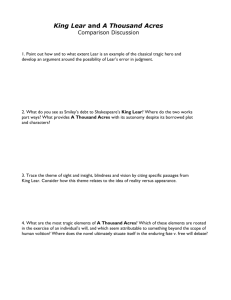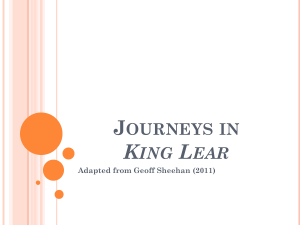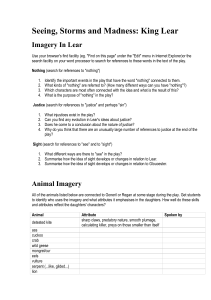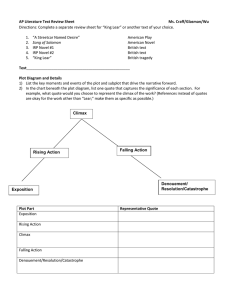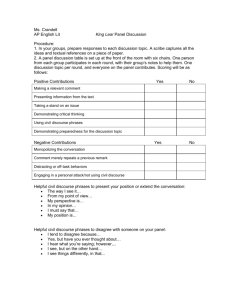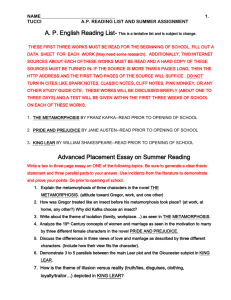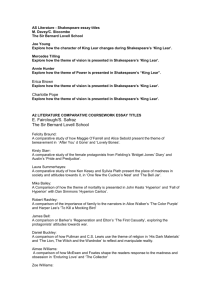William Shakespeare's King Lear
advertisement
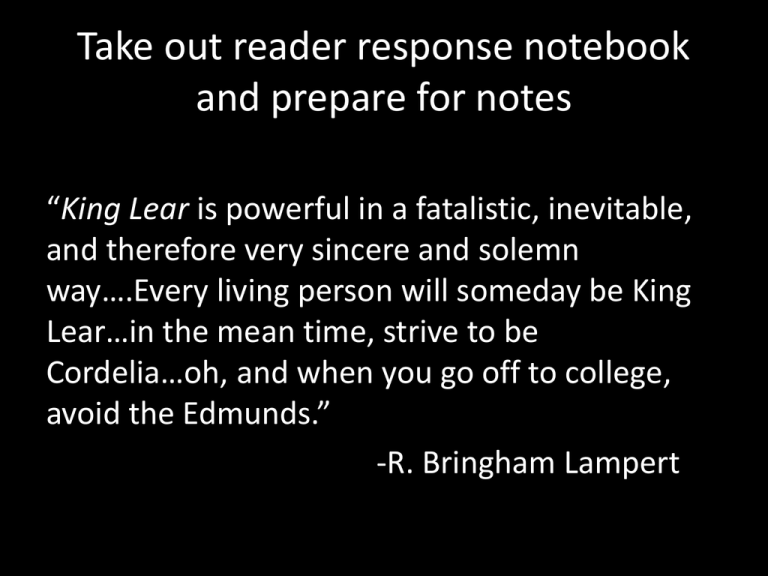
Take out reader response notebook and prepare for notes “King Lear is powerful in a fatalistic, inevitable, and therefore very sincere and solemn way….Every living person will someday be King Lear…in the mean time, strive to be Cordelia…oh, and when you go off to college, avoid the Edmunds.” -R. Bringham Lampert William Shakespeare’s King Lear Date of Composition and Source • Most difficult play to pin down • Written after Hamlet and Othello • Winter of 1605-1606 • “Leir” a folk legend king who never actually existed • Published during his life time Original Title • M. William Shak-speare: His True Chronicle Historie of the life and death of King Lear and his three Daughters. With the unfortunate life of Edgar, sonne and heire to the Earle of Gloster, and his sullen and assumed humor of Tom of Bedlam Lear and European History • One of the few plays to take place in Britain • Similar to other tragedies- nobility • Believed to be during the Hundred Years War (1337-1453) • France loses the battle Where did the story come from? • The story of King Lear originated 400 years before Shakespeare wrote his version. • Lear was a mythological British King who reigned before the birth of Christ allowing Shakespeare to implement some polytheistic elements into the plot. • Shakespeare also “borrowed” from a convenient contemporary true story of a gentleman of the court of Elizabeth I named Sir Brian Annesley whose daughters tried to have him declared insane in late 1603 so they could legally take control of his estate. His youngest daughter, named Cordell, intervened on his behalf. The Plot and Subplot: Two Parallel Stories • Lear and his daughters: Main Plot • Edgar and his father and brother: subplot • Parallel stories: their closeness in plot and direction render them mirrors of each other • Both Lear and Gloucester have faith in the wrong child and reject the right one • Hook: begins in media res (in the middle of things) Kent, Gloucester (Gloss ter), and Edmund enter stage already in conversation Sidenotes • Suicide and the world view that demonstrates the belief that the souls of all who take their lives will be damned forever – punished for her wickedness • The attraction between some key characters -shows the attraction between like-minded individuals – It involves seeking in others for that which you possess in yourself What’s the Significance of the Subplot? Lear has three legitimate daughters. Gloucester has one legitimate son and one illegitimate one. Evil is not confined either to gender or to being illegitimate. It can occur anywhere. Verse • Most of Shakespeare’s plays are written in verse. A character who speaks in verse is a noble or a member of the Upper Class. Most of his plays focused on these characters. • The verse form he used is BLANK VERSE. There is no rhyme, but each line has an internal rhythm with a regular rhythmic pattern. The pattern he liked most was iambic pentameter – 10 syllable line with accent on every other syllable. It is most regular. He sometimes found it necessary to remove a vowel so that the rhythm would work. Tragedy • Protagonist dies while defeating antagonist • In revenge tragedy, the protagonist is driven by desire to exact revenge, which leads to his/her demise • The tragic hero is dominated by a fatal flaw in character, which leads to his/her downfall • The tragic hero is held in high standing, making the downfall more tragic for the audience Aristotelian Hamartia • Poetics: tragic hero is one who is guilty of hamartia, and perhaps hubris • Hamartia: error of judgment • Hubris: excessive pride • Lear is guilty of both • Existential Hero: architect of his own ruin • Fall from high to low Characters • King Lear-Aging King of Britain • Cordelia-Lear’s youngest daughter, disowned for refusing to flatter him • Kent-Nobleman who is loyal to Lear, but outspoken • Gloucester-Nobleman to Lear, suffers a parallel fate • Edgar-Gloucester’s older legitimate son • Fool- Lear’s court jester who gives important advice Characters- Evil • Edmund-Gloucester’s Bastard Son who resents his position; cunning in his schemes • Regan (wife of Cornwall) and Goneril (wife of Albany)- Lear’s daughters who are interested in power and do not care about their father Ah, Deception • In King Lear, Shakespeare offers a world where the natural and unnatural are intertwined, appearances and selfperception are confused, and words— written and spoken— are deceptive. “Tell Them What They Want to Hear” In a world dependent on words for communication, each of us comes to value the spoken and written word. We can all readily identify with a child who “says what his parents want to hear.” So, in “Lear”, you can’t always trust what is said or what is recorded. Major Themes Order vs. Chaos Pride Madness Good vs Evil The Uncaring Universe Loyalty vs. Disloyalty/ Blind Obedience Appearance vs Reality Fate vs. Free Will Reason vs Emotion (Patience vs Passion) The nature of Evil and Justice The Need for Humanity Lear’s journey Pride rage suffering/humiliation madness wisdom death Major Themes (continued) Chaos and the Uncaring Universe a. Chaos results from DIVISION (the kingdom, families, brothers, sisters, b. First Existentialist? (universe has no meaning- 19 th etc.) C) “There is, therefore, no preexistent spiritual realm, no soul…,no cosmic compassion for or interest in human life, no afterlife, no transcendence of worldly existence, no cosmic meta-narrative, no angels and devils…, no divine will, no preset destiny, no inevitable fate.” The Symbols 1. The Storm 2. Blindness and sight 3. The Fool The Symbols (continued 4. Nothingness 5. Nakedness and clothing 6. The Hearth 7. The Hovel 8. The Castle 9. The Coronet Motifs • • • • • Clothing and nakedness Blindness Birds and Animal Imagery Letters Lies/ Betrayal
